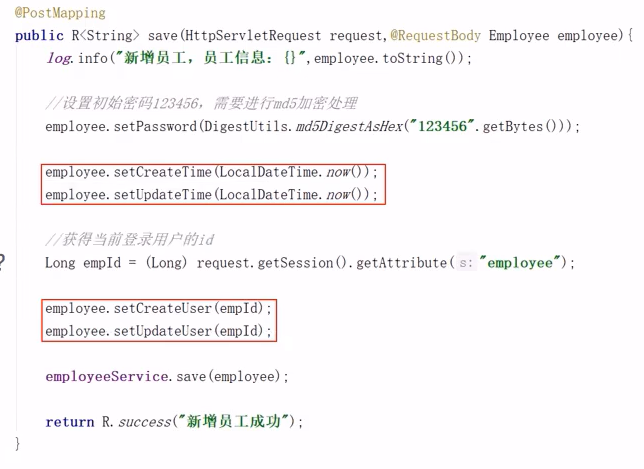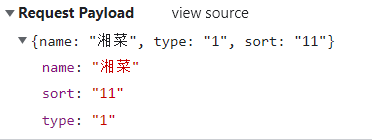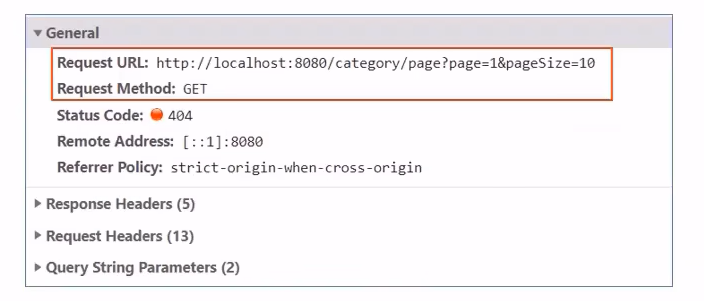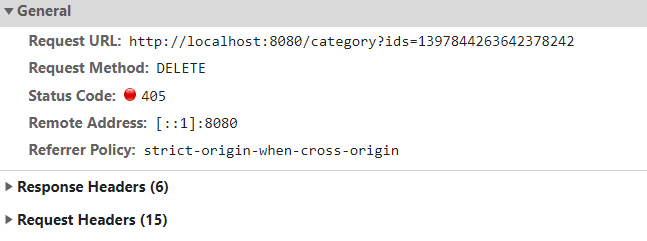开发笔记三
分类管理业务开发
公共字段自动填充
问题分析
前面我们已经完成了后台系统的员工管理功能开发,在新增员工时需要设置创建时间、创建人、修改时间、修改人等字段,在编辑员工时需要设置修改时间和修改人等字段。这些字段属于公共字段,也就是很多表中都有这些字段,如下:


能不能对于这些公共字段在某个地方统一处理,来简化开发呢?答案就是使用Mybatis Plus提供的公共字段自动填充功能
代码实现
Mybatis Plus公共字段自动填充,也就是在插入或者更新的时候为指定字段赋予指定的值,使用它的好处就是可以统一对这些字段进行处理,避免了重复代码。
实现步骤:
1、在实体类的属性上加入@TableField注解,指定自动填充的策略
点击查看代码
@TableField(fill = FieldFill.INSERT)//插入时填充字段
private LocalDateTime createTime;
@TableField(fill = FieldFill.INSERT_UPDATE)//插入和更新时填充字段
private LocalDateTime updateTime;
@TableField(fill = FieldFill.INSERT)
private Long createUser;
@TableField(fill = FieldFill.INSERT_UPDATE)
private Long updateUser;
2、按照框架要求编写元数据对象处理器,在此类中统一为公共字段赋值,此类需要实现MetaObjectHandler接口
点击查看代码
@Component
@Slf4j
public class MyMetaObjectHandler implements MetaObjectHandler {
//插入时自动填充
@Override
public void insertFill(MetaObject metaObject) {
log.info("公共字段自动填充【insert】。。。");
log.info(metaObject.toString());
metaObject.setValue("createTime", LocalDateTime.now());
metaObject.setValue("updateTime", LocalDateTime.now());
metaObject.setValue("createUser",new Long(1));
metaObject.setValue("updateUser",new Long(1));
}
//更新时自动填充
@Override
public void updateFill(MetaObject metaObject) {
log.info("公共字段自动填充【update】。。。");
log.info(metaObject.toString());
metaObject.setValue("updateTime",LocalDateTime.now());
metaObject.setValue("updateUser",new Long(1));
}
}
功能完善
前面我们已经完成了公共字段自动填充功能的代码开发,但是还有一个问题没有解决,就是我们在自动填充createUser和updateUser时设置的用户id是固定值,现在我们需要改造成动态获取当前登录用户的id。
用户登录成功后我们将用户id存入了HttpSession中,现在我从HttpSession中获取不就行了?
注意,我们在MyMetaObjectHandler类中是不能获得HttpSession对象的,所以我们需要通过其他方式来获取登录用户id。
可以使用ThreadLocal来解决此问题,它是JDK中提供的一个类。
在学习ThreadLocal之前,我们需要先确认一个事情,就是客户端发送的每次http请求,对应的在服务端都会分配一个新的线程来处理,在处理过程中涉及到下面类中的方法都属于相同的一个线程:
- LoginCheckFilter的doFilter方法
- EmployeeContraller的update方法
- MyMetaObjectHandler的updateFill方法
可以在上面的三个方法中分别加入下面代码(获取当前线程id):
点击查看代码
long id = Thread.currentThread().getId() ;
log.info("线程id:{}" ,id);
执行编辑员工功能进行验证,通过观察控制台输出可以发现,一次请求对应的线程id是相同的:

什么是ThreadLocal?
ThreadLocal并不是一个Thread,而是Thread的局部变量。当使用ThreadLocal维护变量时,ThreadLocal为每个使用该变量的线程提供独立的变量副本,所以每一个线程都可以独立地改变自己的副本,而不会影响其它线程所对应的副本。
ThreadLocal为每个线程提供单独一份存储空间,具有线程隔离的效果,只有在线程内才能获取到对应的值,线程外则不能访问。
ThreadLocal常用方法:
- public void set(T value) 设置当前线程局部变量的值
- public T get() 返回当前线程所对应的线程局部变量的值
我们可以在LoginCheckFilter的doFilter方法中获取当前登录用户id,并调用ThreadLocal的set方法来设置当前线程的线程局部变量的值(用户id),然后在MyMetaObjectHandler的updateFill方法中调用ThreadLocal的get方法来获得当前线程所对应的线程局部变量的值(用户id)。
实现步骤:
1、编写BaseContext工具类,基于ThreadLocal封装的工具类
点击查看代码
/**
* 基于ThreadLocal封装的工具类,用于保存和获取当前登录用户的id
*/
public class BaseContext {
private static ThreadLocal<Long> threadLocal=new ThreadLocal<>();
public static void setCurrentId(Long id){
threadLocal.set(id);
}
public static Long getCurrentId(){
return threadLocal.get();
}
}
2、在LogincheckFilter的doFilter方法中调用BaseContext来设置当前登录用户的id
点击查看代码
if (request.getSession().getAttribute("employee") != null) {
log.info("用户已登录,用户id为:{}", request.getSession().getAttribute("employee"));
Long empId= (Long) request.getSession().getAttribute("employee");
BaseContext.setCurrentId(empId);
filterChain.doFilter(request, response);
return;
}
3、在MyMeta0bjectHandler的方法中调用BaseContext获取登录用户的id
点击查看代码
@Component
@Slf4j
public class MyMetaObjectHandler implements MetaObjectHandler {
//插入时自动填充
@Override
public void insertFill(MetaObject metaObject) {
log.info("公共字段自动填充【insert】。。。");
log.info(metaObject.toString());
metaObject.setValue("createTime", LocalDateTime.now());
metaObject.setValue("updateTime", LocalDateTime.now());
metaObject.setValue("createUser",BaseContext.getCurrentId());
metaObject.setValue("updateUser",BaseContext.getCurrentId());
}
//更新时自动填充
@Override
public void updateFill(MetaObject metaObject) {
log.info("公共字段自动填充【update】。。。");
log.info(metaObject.toString());
metaObject.setValue("updateTime",LocalDateTime.now());
metaObject.setValue("updateUser",BaseContext.getCurrentId());
}
}
新增分类
需求分析
后台系统中可以管理分类信息,分类包括两种类型,分别是菜品分类和套餐分类。当我们在后台系统中添加菜品时需要选择一个菜品分类,当我们在后台系统中添加一个套餐时需要选择一个套餐分类,在移动端也会按照菜品分类和套餐分类来展示对应的菜品和套餐。


数据模型
新增分类,其实就是将我们新增窗口录入的分类数据插入到category表,表结构如下:

代码开发
在开发业务功能前,先将需要用到的类和接口基本结构创建好:
实体类Category
点击查看代码
@Data
public class Category implements Serializable {
private static final long serialVersionUID = 1L;
private Long id;
//类型 1 菜品分类 2 套餐分类
private Integer type;
//分类名称
private String name;
//顺序
private Integer sort;
//创建时间
@TableField(fill = FieldFill.INSERT)
private LocalDateTime createTime;
//更新时间
@TableField(fill = FieldFill.INSERT_UPDATE)
private LocalDateTime updateTime;
//创建人
@TableField(fill = FieldFill.INSERT)
private Long createUser;
//修改人
@TableField(fill = FieldFill.INSERT_UPDATE)
private Long updateUser;
//是否删除
private Integer isDeleted;
}
Mapper接口CategoryMapper
点击查看代码
@Mapper
public interface CategoryMapper extends BaseMapper<Category> {
}
业务层接口CategoryService
点击查看代码
public interface CategoryService extends IService<Category> {
}
业务层实现类CategoryServicelmpl
点击查看代码
@Service
public class CategoryServicelmpl extends ServiceImpl<CategoryMapper, Category> implements CategoryService {
}
控制层CategoryController
点击查看代码
@Slf4j
@RestController
@RequestMapping("/category")
public class CategoryController {
@Autowired
private CategoryService categoryService;
}
在开发代码之前,需要梳理一下整个程序的执行过程:
1、页面(backend/page/category/list.html)发送ajax请求,将新增分类窗口输入的数据以json形式提交到服务端
2、服务端Controller接收页面提交的数据并调用Service将数据进行保存
3、Service调用Mapper操作数据库,保存数据
可以看到新增菜品分类和新增套餐分类请求的服务端地址和提交的json数据结构相同,所以服务端只需要提供一个方法统一处理即可



点击查看代码
//新增分类
@PostMapping
public R<String> save(@RequestBody Category category){
log.info("category:{}",category);
categoryService.save(category);
return R.success("新增分类成功");
}
分类信息分页查询
需求分析
系统中的分类很多的时候,如果在一个页面中全部展示出来会显得比较乱,不便于查看,所以一般的系统中都会以分页的方式来展示列表数据。
代码开发
在开发代码之前,需要梳理一下整个程序的执行过程:
1、页面发送ajax请求,将分页查询参数(page,pageSize)提交到服务端
2、服务端Controller接收页面提交的数据并调用Service查询数据
3、Service调用Mapper操作数据库,查询分页数据
4、Controller将查询到的分页数据响应给页面
5、页面接收到分页数据并通过ElementUI的Table组件展示到页面上

点击查看代码
@GetMapping("/page")
public R<Page> page(int page, int pageSize) {
//构造分页构造器
Page<Category> pageInfo=new Page<>(page,pageSize);
//构造条件构造器
LambdaQueryWrapper<Category> queryWrapper=new LambdaQueryWrapper<>();
//添加排序条件,根据sort进行排序
queryWrapper.orderByAsc(Category::getSort);
//进行分页查询
categoryService.page(pageInfo,queryWrapper);
return R.success(pageInfo);
}
删除分类
需求分析
在分类管理列表页面,可以对某个分类进行删除操作。需要注意的是当分类关联了菜品或者套餐时,此分类不允许删除。
代码开发
在开发代码之前,需要梳理一下整个程序的执行过程:
1、页面发送ajax请求,将参数(id)提交到服务端

2、服务端Controller接收页面提交的数据并调用Service删除数据
3、Service调用Mapper操作数据库
点击查看代码
//根据id删除分类
@DeleteMapping
public R<String> delete(Long ids){
log.info("删除分类,id为{}",ids);
categoryService.removeById(ids);
//代码完善之后categoryService.remove(ids);
return R.success("分类信息删除成功");
}
代码完善
前面我们已经实现了根据id删除分类的功能,但是并没有检查删除的分类是否关联了菜品或者套餐,所以我们需要进行功能完善。
要完善分类删除功能,需要先准备基础的类和接口:
1、实体类Dish和Setmeal
点击查看代码
@Data
public class Dish implements Serializable {
private static final long serialVersionUID = 1L;
private Long id;
//菜品名称
private String name;
//菜品分类id
private Long categoryId;
//菜品价格
private BigDecimal price;
//商品码
private String code;
//图片
private String image;
//描述信息
private String description;
//0 停售 1 起售
private Integer status;
//顺序
private Integer sort;
@TableField(fill = FieldFill.INSERT)
private LocalDateTime createTime;
@TableField(fill = FieldFill.INSERT_UPDATE)
private LocalDateTime updateTime;
@TableField(fill = FieldFill.INSERT)
private Long createUser;
@TableField(fill = FieldFill.INSERT_UPDATE)
private Long updateUser;
//是否删除
private Integer isDeleted;
}
点击查看代码
@Data
public class Setmeal implements Serializable {
private static final long serialVersionUID = 1L;
private Long id;
//分类id
private Long categoryId;
//套餐名称
private String name;
//套餐价格
private BigDecimal price;
//状态 0:停用 1:启用
private Integer status;
//编码
private String code;
//描述信息
private String description;
//图片
private String image;
@TableField(fill = FieldFill.INSERT)
private LocalDateTime createTime;
@TableField(fill = FieldFill.INSERT_UPDATE)
private LocalDateTime updateTime;
@TableField(fill = FieldFill.INSERT)
private Long createUser;
@TableField(fill = FieldFill.INSERT_UPDATE)
private Long updateUser;
//是否删除
private Integer isDeleted;
}
2、Mapper接口DishMapper和SetmealMapper
点击查看代码
@Mapper
public interface DishMapper extends BaseMapper<Dish> {
}
点击查看代码
@Mapper
public interface SetmealMapper extends BaseMapper<Setmeal> {
}
3、Service接口DishService和SetmealService
点击查看代码
public interface DishService extends IService<Dish> {
}
点击查看代码
public interface SetmealService extends IService<Setmeal> {
}
4、Service实现类DishServicelmpl和SetmealServicelmpl
点击查看代码
@Service
public class DishServiceImpl extends ServiceImpl<DishMapper, Dish> implements DishService {
}
点击查看代码
@Service
public class SetmealServiceImpl extends ServiceImpl<SetmealMapper, Setmeal> implements SetmealService{
}
关键代码
在CategoryService添加remove方法
点击查看代码
public interface CategoryService extends IService<Category> {
public void remove(Long id);
}
在CategoryServicelmpl实现remove方法
点击查看代码
@Service
public class CategoryServicelmpl extends ServiceImpl<CategoryMapper, Category> implements CategoryService {
@Autowired
private DishService dishService;
@Autowired
private SetmealService setmealService;
@Override
public void remove(Long id) {
LambdaQueryWrapper<Dish> dishLambdaQueryWrapper=new LambdaQueryWrapper<>();
//添加查询条件,根据分类id进行查询
dishLambdaQueryWrapper.eq(Dish::getCategoryId,id);
int count1 = dishService.count(dishLambdaQueryWrapper);
//查询当前分类是否关联菜品,如果已经关联,抛出业务异常
if(count1>0){
//已经关联菜品,抛出业务异常
throw new CustomException("已经关联菜品,不能删除");
}
//查询当前分类是否关联了套餐,如果已经关联,抛出业务异常
LambdaQueryWrapper<Setmeal> setmealLambdaQueryWrapper=new LambdaQueryWrapper<>();
//添加查询条件,根据分类id进行查询
setmealLambdaQueryWrapper.eq(Setmeal::getCategoryId,id);
int count2 = setmealService.count(setmealLambdaQueryWrapper);
if(count2>0){
//已经关联套餐,抛出业务异常
throw new CustomException("已经关联套餐,不能删除");
}
//正常删除分类
super.removeById(id);
}
}
定义异常类CustomException
点击查看代码
public class CustomException extends RuntimeException{
public CustomException(String message){
super(message);
}
}
在全局异常处理器GlobalExceptionHandler添加
点击查看代码
//进行异常处理方法
@ExceptionHandler(CustomException.class)
public R<String> exceptionHandler(CustomException ex){
log.error(ex.getMessage());
return R.error(ex.getMessage());
}
修改分类
需求分析
在分类管理列表页面点击修改按钮,弹出修改窗口,在修改窗口回显分类信息并进行修改,最后点击确定按钮完成修改操作
代码实现
点击查看代码
//修改分类
@PutMapping
public R<String> update(@RequestBody Category category){
categoryService.updateById(category);
return R.success("分类修改成功");